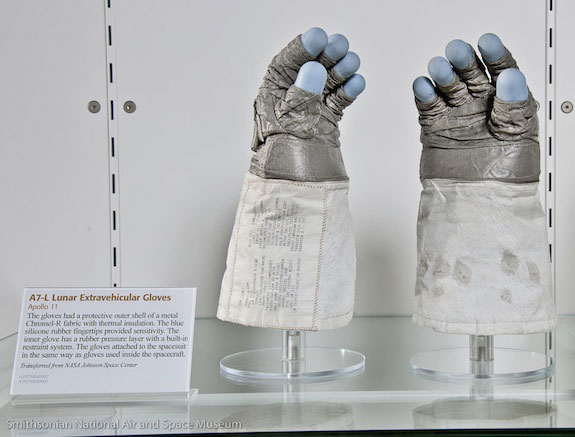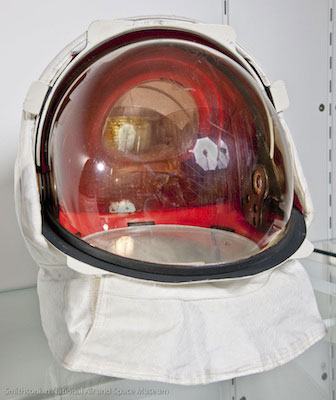Neil Armstrong’s gloves and visor go on display

Neil Armstrong’s Visor and Gloves. Armstrong wore these items when he walked on the moon. (Photo by Dane Penland)
For two weeks only, both the gloves and visor worn by astronaut Neil Armstrong on the historic mission to the moon will be on display at the Udvar-Hazy Center. Taken from storage, where his flight suit remains, the objects offer a way for visitors to engage with the legendary man who died August 5.
Curator Cathy Lewis says the museum wanted to bring the delicate objects out of storage, “In honor of Neil Armstrong and his life and his work, but also just to give our visitors a sense of human scale.”

These silicone-tipped gloves protected Armstrong from cuts while working on the surface of the moon. (Photo by Dane Penland)
The objects also reflect the cutting edge technologies first employed on the historic Apollo mission. The gloves, for example, include blue silicone fingertips and Chromel-R, a stainless-steel, high-chromium fabric, wrapping around the hands. The materials, explains Lewis, were “used in spacesuit design during the Apollo program quite frugally as it was very expensive fabric, but it protected the astronauts against cuts and scrapes while working on the surface of the moon.”
The gloves were custom-made and hand-sewn for Armstrong. They also feature a reminder checklist on the cuffs, “that goes through all the procedures and standards for preparing for space walks.”
Meanwhile, the visor, which attached to the bubble helmet, helped protect against solar radiation and micrometeorites.
Lewis admires the spirit of ingenuity behind the design of both objects, saying: “It’s a combination of both very rudimentary technology and also very advanced thinking and engineering.”
Ultimately, the objects are about more than technology, though. “These are the gloves that he used. They’re still here and his legacy and what he accomplished still lives on,” says Lewis, adding, ”It’s not just Neil Armstrong, it reflects all of those people who were behind him.”
This post by Leah Binkovitz of the Air and Space Museum was originally published by the Smithsonian.com blog, Around the Mall.
Posted: 6 September 2012
-
Categories:
Air and Space Museum , Feature Stories , History and Culture , Science and Nature




